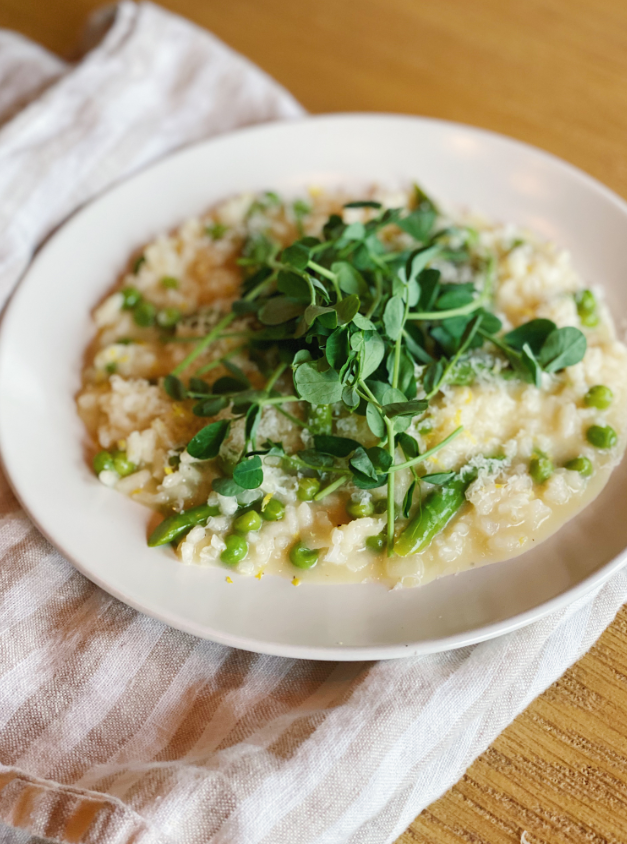Spring Risotto With Asparagus, Peas and Lemon
Risotto is my love language and this spring version is my new favorite way to make it! I looove the fresh, seasonal element that the asparagus and peas give the dish. When paired with the brightness from the lemon, it’s the perfect compliment to the rich, creamy, cheesy rice. I’m definitely going to be cooking this regularly all season long!
Before I dive into the recipe, I want to call out a few quick key things we learned about risotto in culinary school. I think these nuggets are super valuable and they help you achieve restaurant-quality risotto at home!
Butter – risotto is a traditional Northern Italian dish and Northern Italy is green and lush, which makes it a prime place for cattle + livestock to live. Because of this, they have more access to milk (and butter), so Northern Italian dishes traditionally use butter as the fat. This is why a traditional risotto is made with butter instead of olive oil. You can of course use olive oil if you prefer or have it around but thought this was really interesting!
Rice – you want to use a short grain white rice for risotto. The short grain rice has a lot of starch content and it can absorb a lot of liquid. Both are key factors to a creamy, luscious risotto. The two more widely available types of short grain rice in the US are Carnaroli (my personal fav!) and Arborio.
Coating the rice in butter – it’s really important to cook the rice in the butter/softened onion mixture for a few minutes (until the rice grains are white/opaque) before adding the wine and broth. That said, you don’t want to brown the rice during this process, so adjust the heat accordingly. By coating the rice in the fat for a little bit, you’re creating a barrier of butter on the outside of the rice, which helps the rice slowly absorb the broth over the course of cooking. This slow absorption of broth is key to a creamy end product.
Stir often, not constantly – risotto is so creamy and luscious because you’re agitating the rice grains as you stir them, releasing their starches. That said, if you stir the rice excessively, it will end up too thick and gummy by the end. You want to stir the risotto every couple of minutes (to prevent sticking and uneven cooking) but you can walk away for a second in between stock additions and let it do its thing too! The end goal (for a traditional risotto) is that you want to be able to see the liquid between the grains of rice in the final product. The risotto should spill out a little when you plate it – it shouldn’t stay put in a thick glob. All that said, if your risotto ends up a little thicker, that’s totally OK – it’ll taste delicious regardless!
Serves 6-8
INGREDIENTS
1 bunch asparagus, cut into 1-inch spears on a bias
Kosher salt
2 quarts stock (chicken, veggie or Parmesan broth)
6 Tbsp butter, divided (can use salted or unsalted)
3/4 cup diced yellow onion
2 cups Arborio or Carnaroli rice
1/2 cup white wine
1 1/2 cup grated Parmesan cheese
Juice from 1 lemon
1 Tbsp lemon zest, from ~2 lemons (plus more for garnish)
1 cup frozen peas, defrosted
Freshly ground black pepper
Pea shoots for garnish (optional)
METHOD
Bring a medium pot of water up to a boil. Once boiling, add a couple tablespoons of kosher salt and the sliced asparagus. Blanch the asparagus for 2 minutes, until they’re tender but still have a little bite. Transfer to an ice bath immediately to stop the cooking process. Set aside.
Bring the stock up to a simmer in a large pot on the back burner. Turn off the heat and put the lid on to keep the stock warm.
Meanwhile, heat a large saute pan over medium-low heat and add 4 Tbsp of the butter. Once the butter is melted, add the onion and a pinch of kosher salt and cook until the onion is soft but not brown, 2-3 minutes.
Add the rice to the softened onions. Stir to coat the rice with the butter and cook for a couple of minutes until the rice has turned opaque. You don’t want to brown the rice, so turn down the heat, if necessary.
Add the wine and stir. Once the rice has absorbed the wine, add a ladle-full (about 1 cup) of the warm stock. Stir every couple of minutes. The heat should be medium-low at this point. You want the liquid to be gently simmering. Once the majority of the stock has been absorbed by the rice, add another ladle-full of stock.
Continue this process – adding a ladle of stock, stirring often but not constantly, and waiting for the rice to almost completely absorb each addition of stock before adding the next. Do this until all of the warm stock has been added and absorbed and the rice is cooked to al dente (has a little bit of a bite to it). This will take 20-30 minutes. See #4 in the keys to a good risotto above for what the final product should look like!
Turn off the heat and stir in the reserved blanched asparagus, grated Parmesan cheese, remaining 2 Tbsp butter, defrosted peas, lemon juice and zest. Add kosher salt and freshly ground pepper, to taste.
Serve topped with more lemon zest, grated Parmesan cheese and pea shoots.
NOTES
Substitutions – If you don’t have asparagus or peas, you can skip them! You can still add the lemon if you want a lemony risotto or you can remove the lemon completely. This recipe is also the base for adding tons of other flavor combinations, so if you don’t have asparagus or peas, you can easily sub out! Just add your veggies of choice in step seven, along with the Parmesan cheese, 2 Tbsp butter, salt and pepper to taste! You can add sauteed mushrooms, roasted butternut squash, etc. Just make sure that you’ve pre-cooked these ingredients separately before adding. If you were to add them at the beginning when you saute the onions in step three, they will be overcooked by the time the risotto is done. Sauteeing them separately allows you to control the done-ness and also the flavor of the veggies.



